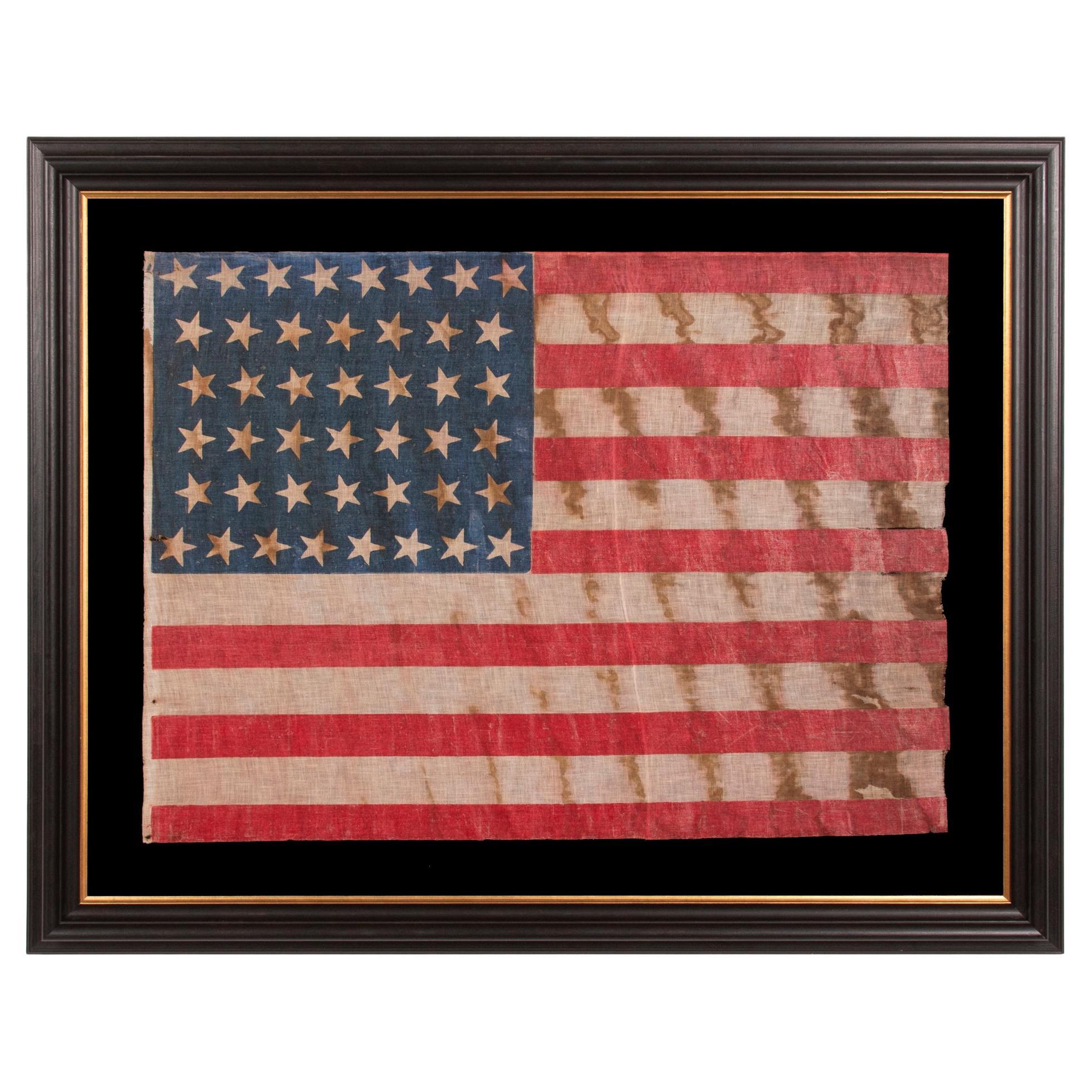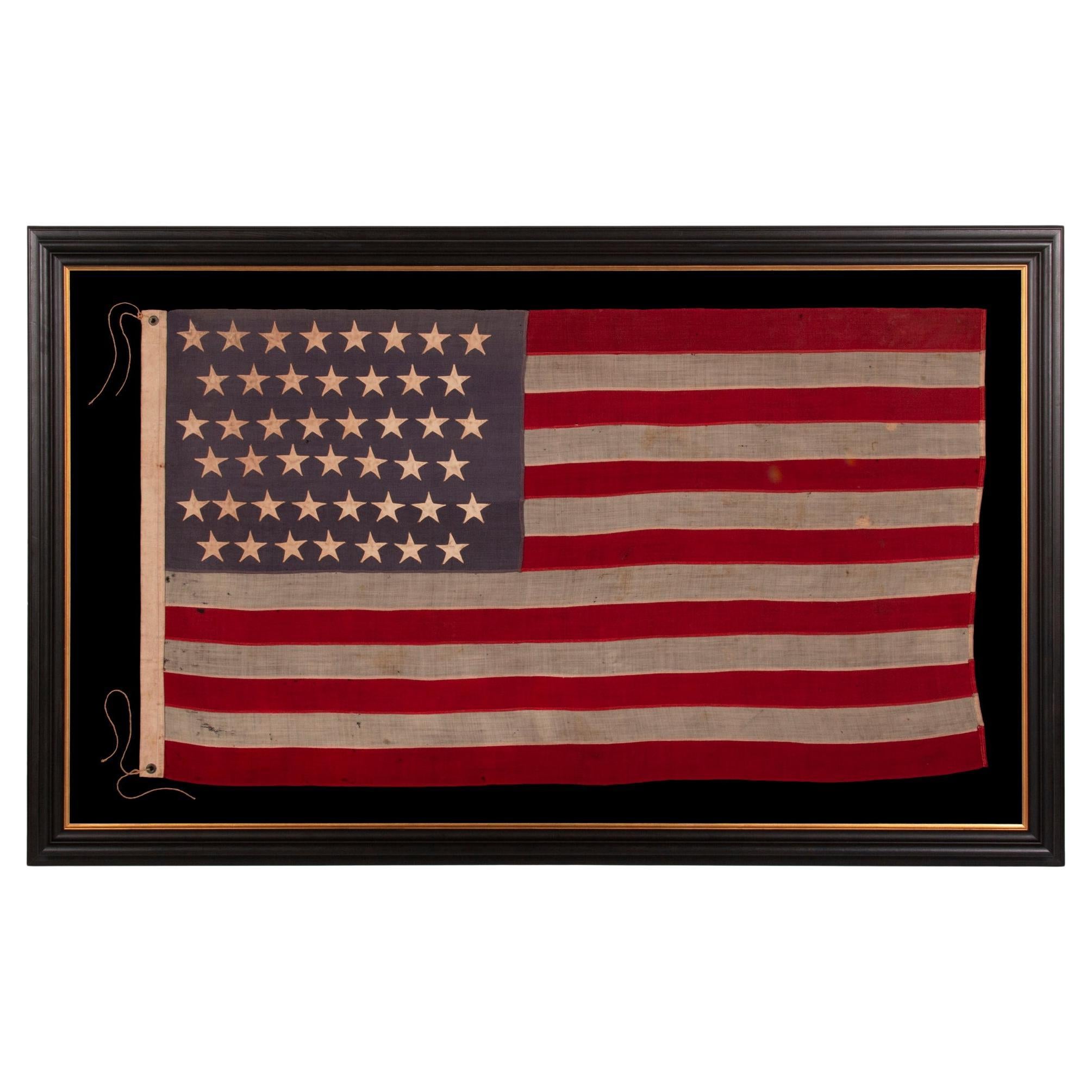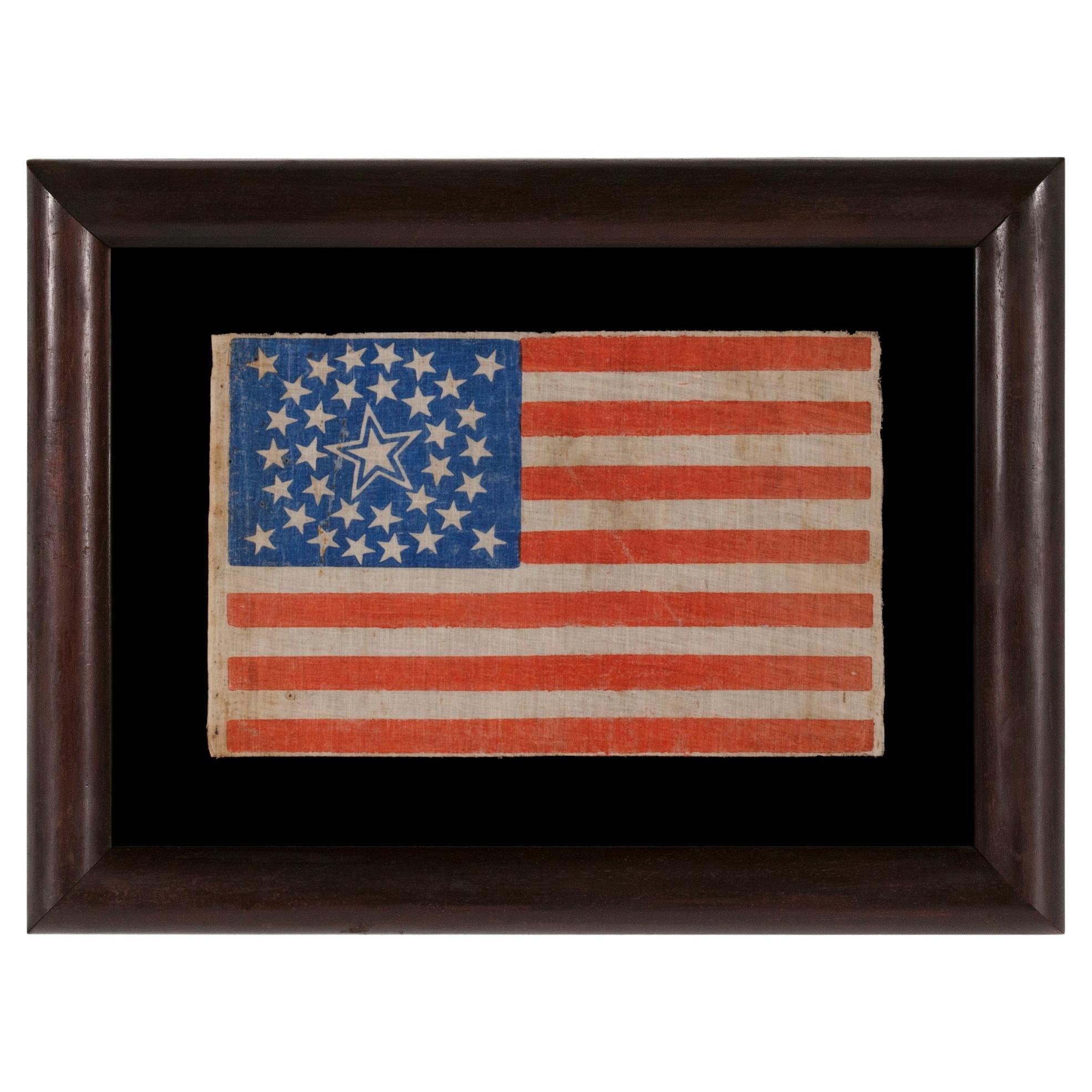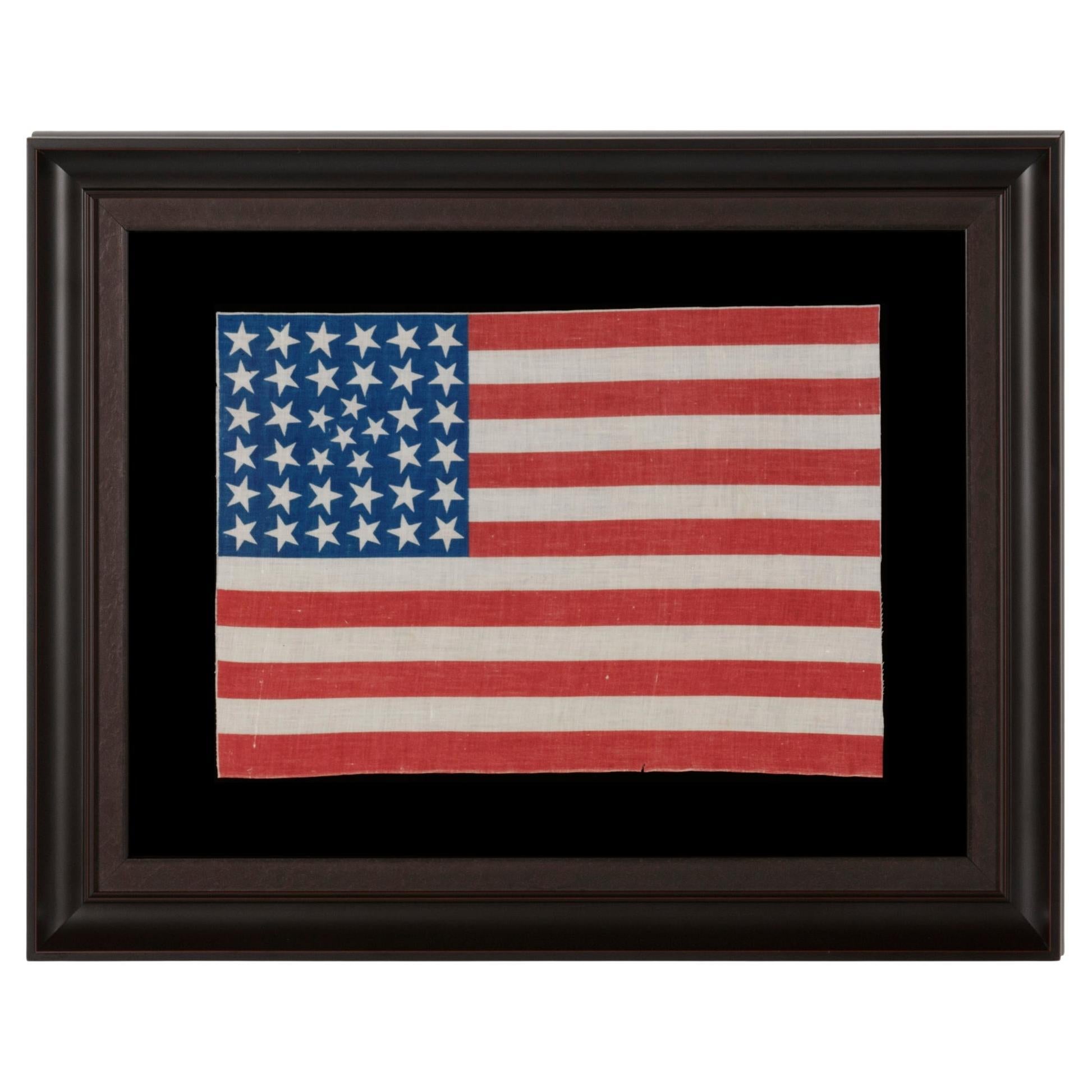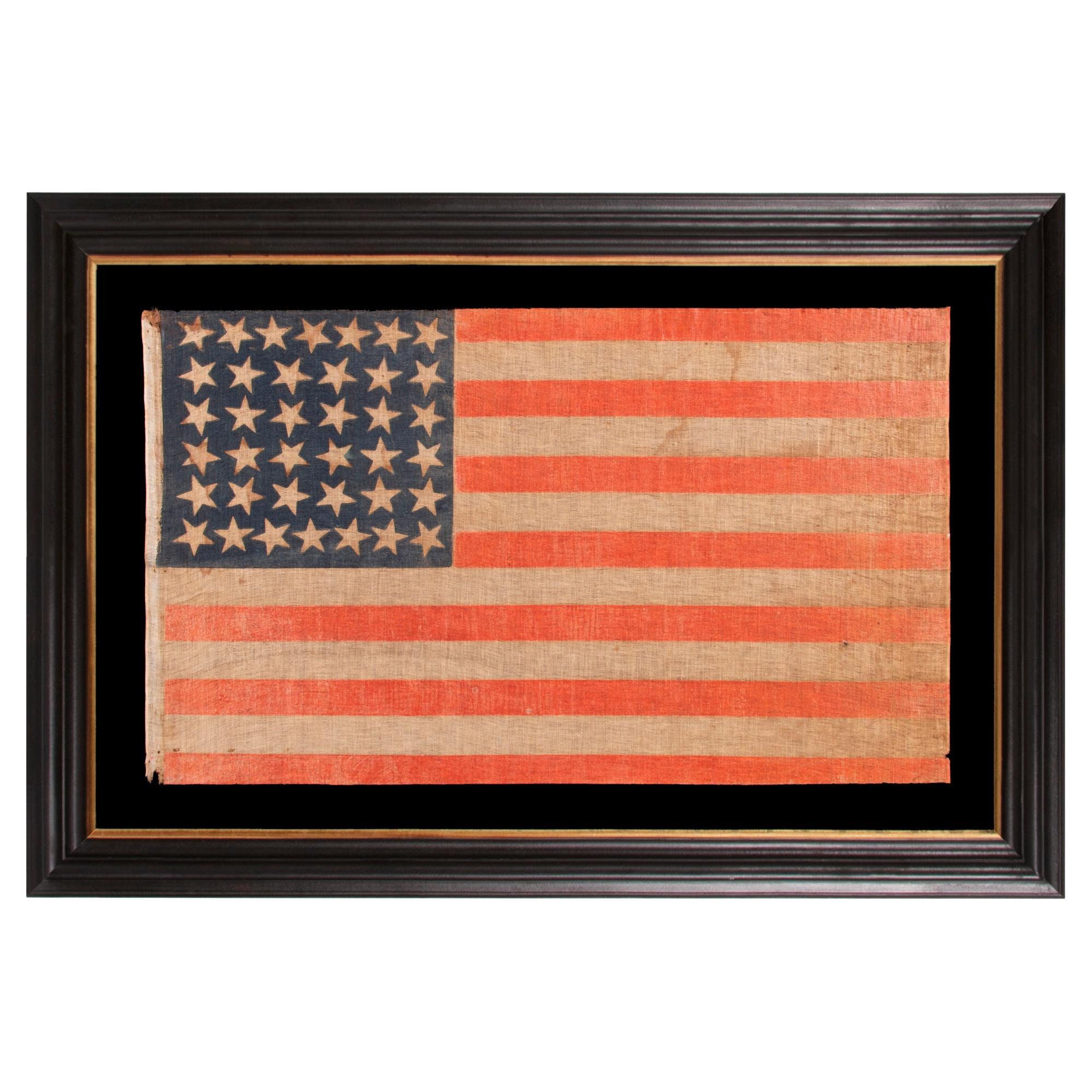Items Similar to 44 Star Antique Parade Flag, Hourglass Formation, Wyoming Statehood ca 1890-1896
Want more images or videos?
Request additional images or videos from the seller
1 of 6
44 Star Antique Parade Flag, Hourglass Formation, Wyoming Statehood ca 1890-1896
About the Item
44 STAR ANTIQUE AMERICAN FLAG WITH AN HOURGLASS FORMATION ON A BRILLIANT BLUE CANTON; REFLECTS THE ERA WHEN WYOMING WAS THE MOST RECENT STATE TO JOIN THE UNION, 1890-1896
44 star American national parade flag, block-printed on coarse cotton. The stars of this particular example are configured in rows of 8-7-7-7-7-8, with the top and bottom rows offset so that they resemble a broad hourglass. This lineal formation is often encountered on flags of this star count and is graphically attractive. Note how the position of the stars on their vertical axis varies from one row to the next. In the first row, the stars are canted to the left, with one point facing towards 11:00. In the next row they lean to the opposite direction, with one point facing toward 1:00, alternating back-and-forth from one row to the next throughout the formation. I have termed this configuration "dancing rows," though it may also accurately be referred to as tilting or canted rows.
Note the brilliant, royal blue color of the canton and how nicely it presents with this particular shade of scarlet red. The fact that the blue pigment continues down the hoist is an unusual feature, as well as an attractive one. This was due to the manner in which other flags were printed on the same bolt of fabric.
Wyoming was admitted as the 44th state on July 10th, 1890. Although the 44 star count would not become official until July 4th of the following year, flag makers would have begun to add a 44th star immediately, if not even beforehand, in hopeful anticipation. This became common among flag-makers during the latter 19th century, a practice that reflected both their support of westward expansion and a drive not to be out-stepped by their competitors. While the 44 star count remained so until July 3rd, 1896, it would have generally fallen out of use at the beginning of that year, when Utah gained statehood on January 4th.
The background is 100% cotton twill, black in color. The mount was placed in a shadowbox depth molding with a step-down profile molding and a finish that is a very dark brown in color, nearly black, with reddish highlights and undertones, to which a black-painted and hand-gilded Italian molding was added as a liner. The glazing is U.V. protective acrylic (Plexiglas). Feel free to contact us for more details.
Condition: There is minor to modest foxing and soiling throughout, accompanied by very minor pigment loss and fading. There are tiny tack holes along the hoist, where the flag was once affixed to its original wooden staff. The flag shows its age gracefully and presents wonderfully because of it.
Frame Size (H x L): 20" x 25.25"
Flag Size (H x L): 12" x 17"
- Dimensions:Height: 20 in (50.8 cm)Width: 25.25 in (64.14 cm)Depth: 2 in (5.08 cm)
- Materials and Techniques:
- Place of Origin:
- Period:
- Date of Manufacture:1890-1896
- Condition:See Item Description.
- Seller Location:York County, PA
- Reference Number:
About the Seller
5.0
Recognized Seller
These prestigious sellers are industry leaders and represent the highest echelon for item quality and design.
Established in 1991
1stDibs seller since 2008
61 sales on 1stDibs
Typical response time: 10 hours
- ShippingRetrieving quote...Ships From: York County, PA
- Return PolicyThis item cannot be returned.
More From This SellerView All
- 44 Star Antiques American Flag, Wyoming Statehood, ca 1890-1896Located in York County, PA44 STAR ANTIQUE AMERICAN FLAG WITH AN HOURGLASS FORMATION OF STARS IN CANTED ROWS, AND AN EXTREMELY INTERESTING PRESENTATION FROM REPEATING SWATHS OF HEAVY OXIDATION, WYOMING STATEHO...Category
Antique Late 19th Century American Political and Patriotic Memorabilia
MaterialsCotton
- 45 Star Antique American Flag, with Staggered Rows, Utah Statehood, ca 1890-1896Located in York County, PA45 STAR ANTIQUE AMERICAN FLAG WITH STAGGERED ROWS OF STARS ON A DUSTY BLUE CANTON; REFLECTS THE PERIOD WHEN UTAH WAS THE MOST RECENT STATE TO JOIN THE UNION, 1890-1896 Utah became t...Category
Antique 1890s American Political and Patriotic Memorabilia
MaterialsWool
- 45 Star Antique American Flag, Utah Statehood, Ca 1896-1908Located in York County, PA45 STAR ANTIQUE AMERICAN PARADE FLAG WITH ITS STARS ARRANGED IN A NOTCHED PATTERN, 1896-1908, UTAH STATEHOOD 45 star American national flag, printed on coarse, glazed cotton. Eviden...Category
Antique Late 19th Century American Political and Patriotic Memorabilia
MaterialsCotton
- 34 Star Antique American Parade Flag, Kansas Statehood, ca 1861-1863Located in York County, PA34 STARS IN A MEDALLION CONFIGURATION ON AN ANTIQUE AMERICAN PARADE FLAG WITH A LARGE, HALOED CENTER STAR; CIVIL WAR PERIOD, KANSAS STATEHOOD, 1861-1863 34 star American national pa...Category
Antique 1860s American Political and Patriotic Memorabilia
MaterialsCotton
- 38 Star Antique American Parade Flag, Colorado Statehood, ca 1876-1889Located in York County, PA38 STARS IN AN EXTREMELY UNUSUAL CONFIGURATION THAT BEARS A CLUSTER OF 6 SMALL STARS WITHIN A LINEAL PATTERN OF LARGER STARS, 1876-1889, COLORADO STATEHOOD 38 star American national parade flag, printed on cotton. This is an extremely rare example of a lineal pattern flag with a wreath or cluster of smaller stars inserted in the center. A very small number of flags in this style are known to have survived, the colors of which are typically saturated and vibrant, like this example, in scarlet red and rich, royal blue. The particular wreath in the center of the configuration is really more of a pentagon with a single, center star. The reason for the choice of the design and 6 smaller stars seems a curious one on the surface, but its purpose was probably nothing more than to simply augment a 36 star print block to one with 38 stars. One may observe how 4 stars, that would have comprised the center of a 6 x 6 pattern, could have simply been removed and 6 smaller stars inserted in their place, in an artful fashion. At least two other similar 38-star patterns are known that incorporate 4 small stars intermingled between rows of what most certainly were two very similar 34-star flag print blocks originally. It was easier to modify these blocks rather than create brand new ones. In these particular instances, the results are rare, quirky configurations that are highly prized by collectors. Colorado became the 38th state on August 1st, 1876. This was the year of our nation’s 100-year anniversary of independence. Per the Third Flag Act of 1818, stars were not officially added until the 4th of July following a state's addition. For this reason, 37 was the official star count for the American flag in 1876. Flag-making was a competitive venture, however, and few flag-makers would have been continuing to produce 37 star flags when their competitors were making 38’s. It is for this reason that 38 and 13 stars (to represent the original 13 colonies) are more often seen at the Centennial International Exposition, the six-month long World’s Fair held in Philadelphia in honor of the event. Some flag-makers would have been adding a star for the 38th state even before it entered the Union, in the early part of 1876 or even prior. In fact, many makers of parade flags were actually producing 39 star flags, in hopeful anticipation of the addition of two more Western Territories instead of one. But the 39th state would not join the Union for another 13 years, when the Dakota Territory entered as two states on the same day. The 38 star flag became official on July 4th, 1877 and was generally used until the addition of the Dakotas in 1889. Provenance: Jeff R. Bridgman Antiques to the late collector Jim Ring...Category
Antique Late 19th Century American Political and Patriotic Memorabilia
MaterialsCotton
- 38 Star Antique American Parade Flag, Colorado Statehood, ca 1876-1889Located in York County, PA38 STAR ANTIQUE AMERICAN PARADE FLAG WITH JUSTIFIED ROWS OF 7-6-6-6-6-7 AND SCATTERED STAR ORIENTATION, MADE DURING THE PERIOD WHEN COLORADO WAS THE MOST RECENT STATE TO JOIN THE UNION, 1876-1889 38 star American national parade flag, printed on coarse cotton, possibly with flax content. One of the flag’s most interesting features is the wild sweep of the grain of the fabric, the warp and weft of which are anything but perpendicular. The stars are arranged in justified rows of 7-6-6-6-6-7. This results in a secondary pattern that I commonly call a “box-in-a-box-in-a-box”, because of the way in which the seemingly haphazard arrangement creates three consecutive squares. Note how the stars point in various directions on their vertical axis, which adds a nice element of folk quality to the overall design. Most parade flags in this star count have red stripes that lean heavily toward orange, with a vibrant, chromatic luster. This was common across printed flags produced between the 1850's and the 38 star period, phasing out in the last decade of the 19th century. Also note how the wear and patina contribute to an endearing presentation that displays its long-term use gracefully. Colorado became the 38th state on August 1st, 1876. This was the year of our nation’s 100-year anniversary of independence. Per the Third Flag Act of 1818, stars were not officially added until the 4th of July following a state's addition. For this reason, 37 was the official star count for the American flag in 1876. In the latter 19th century, it became common to add stars before the respective state(s) had even entered the Union. No one cared what was official, not even the military, where the matter of practicality with regard to flags always seems to have outweighed regulations. In the private sector, commercial flag-making was a competitive venture. Few flag-makers continued to produce 37 star flags when their competitors had jumped the star count to 38. It is for this reason that 38 and 13 stars (to represent the original 13 colonies) are more often seen at the Centennial International Exposition, the six-month long World’s Fair, held in Philadelphia, that served as the nucleus of the national celebration. Some makers of printed parade flags actually began to produce 39 star flags in 1876, in hopeful anticipation of the addition of two more Western Territories instead of one. The 39th state would not join the Union for another 13 years, however, when the Dakota Territory—thought to be coming as a single state—entered as two separate states on November 2nd, 1889. The 38 star flag generally fell out of production at that time, though it technically remained official until July 3rd, 1890. President Ulysses S. Grant was in office when the first 38 star flags would have appeared. The list of presidents that served during the period when the 38 star flag was official include Rutherford B. Hayes, James Garfield...Category
Antique Late 19th Century American Political and Patriotic Memorabilia
MaterialsCotton
You May Also Like
- 31-Star Printed American Flag, Celebrating California Statehood, Circa 1850Located in Colorado Springs, COThis is a rare 31-star medallion printed American flag, celebrating the addition of California to the Union. The flag is printed on silk and has a spectacular “Great Star” canton pat...Category
Antique 1850s American Political and Patriotic Memorabilia
MaterialsSilk
- 1889 North Dakota 39 Star United States of America Statehood FlagLocated in Coeur d'Alene, ID39 star silk statehood flag. 23 1/2" x 15". Was the unofficial North Dakota Flag. As South Dakota was also admitted as the 40th state on the same day this...Category
Antique 1880s American Historical Memorabilia
MaterialsSilk
- Rare Monumental 1890 Antique 42 Star United States of America FlagLocated in Dayton, OHMonumental fifteen foot 42 star American flag, circa 1889-1890. The 42-star flag is rare because only a limited number of 42-star flags were produced after Washington became a state on Nov. 11, 1889. But it takes a more intimate knowledge of flag trivia to know just why it happened this way. White stars are added to the blue field of the star-spangled banner on the Fourth of July after a state is admitted to the union. In the fall of 1889, several western territories became states. Dakota was admitted, and then split into North and South Dakota, on Nov. 2, 1889, which made them state and star numbers 39 and 40. Montana was named the 41st state on Nov. 8, followed by Washington, on Nov. 11. Only a few flag manufacturers began producing 42-star flags before the official addition of the 42nd star on July 4, 1890. Those who tried to jump the gun by being the first to produce an up-to-date flag were surprised when Idaho was admitted to the United States on July 3...Category
Antique 1890s American Classical Historical Memorabilia
MaterialsCotton
- 38-Star Antique American Flag with Unique Canton, circa 1876-1890Located in Colorado Springs, COThis is a striking 38-star American flag. The flag dates to 1876-1890, when Colorado (represented by the large star in the center of the flag’s canton) joined the Union as the 38th s...Category
Antique Late 19th Century American Political and Patriotic Memorabilia
MaterialsMuslin
- Original Painted Metal Parade FlagLocated in Los Angeles, CAThis fun and folky 20thc original painted parade flag sign was used to hand in the windows during patriotic events. In stores and homes in the early 20thc.Category
Antique Late 19th Century American Adirondack Political and Patriotic Me...
MaterialsTin
- 39-Star Antique American Flag with 'Whimsical' Star Pattern, 1889Located in Colorado Springs, COThis is a 39-star unofficial American flag, handmade and printed on cotton. The flag dates to 1889 and has a unique history, thanks to its rare star-count. The flag’s canton is prin...Category
Antique 1880s American Political and Patriotic Memorabilia
MaterialsCotton
Recently Viewed
View AllMore Ways To Browse
Modern Pennants
Flag Pole With Eagle
Korean Flag
Folk Art American Eagle
Antique American Flag 49 Stars
Chinese Porcelain Lunch Box
Pennant Banner
Prints Men In Confederate Uniform
Star Wars Prop
Hermes Scarf Folk
Toy Sewing Machine
Uss Utah
A Moderate Gale
Antique Jewelry Lancaster Pa
Grand Duchess Tatiana
Rosenthal Iwo Jima
Toy Singer Sewing Machine
Buermann Spurs
